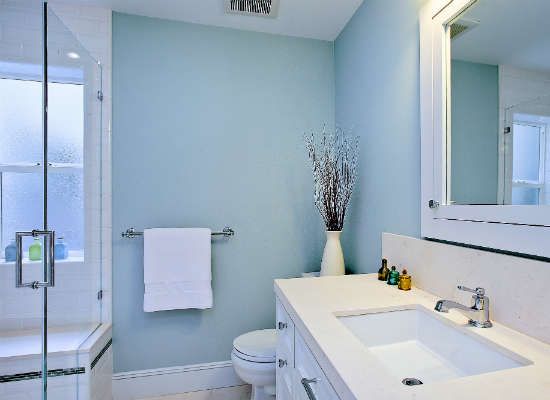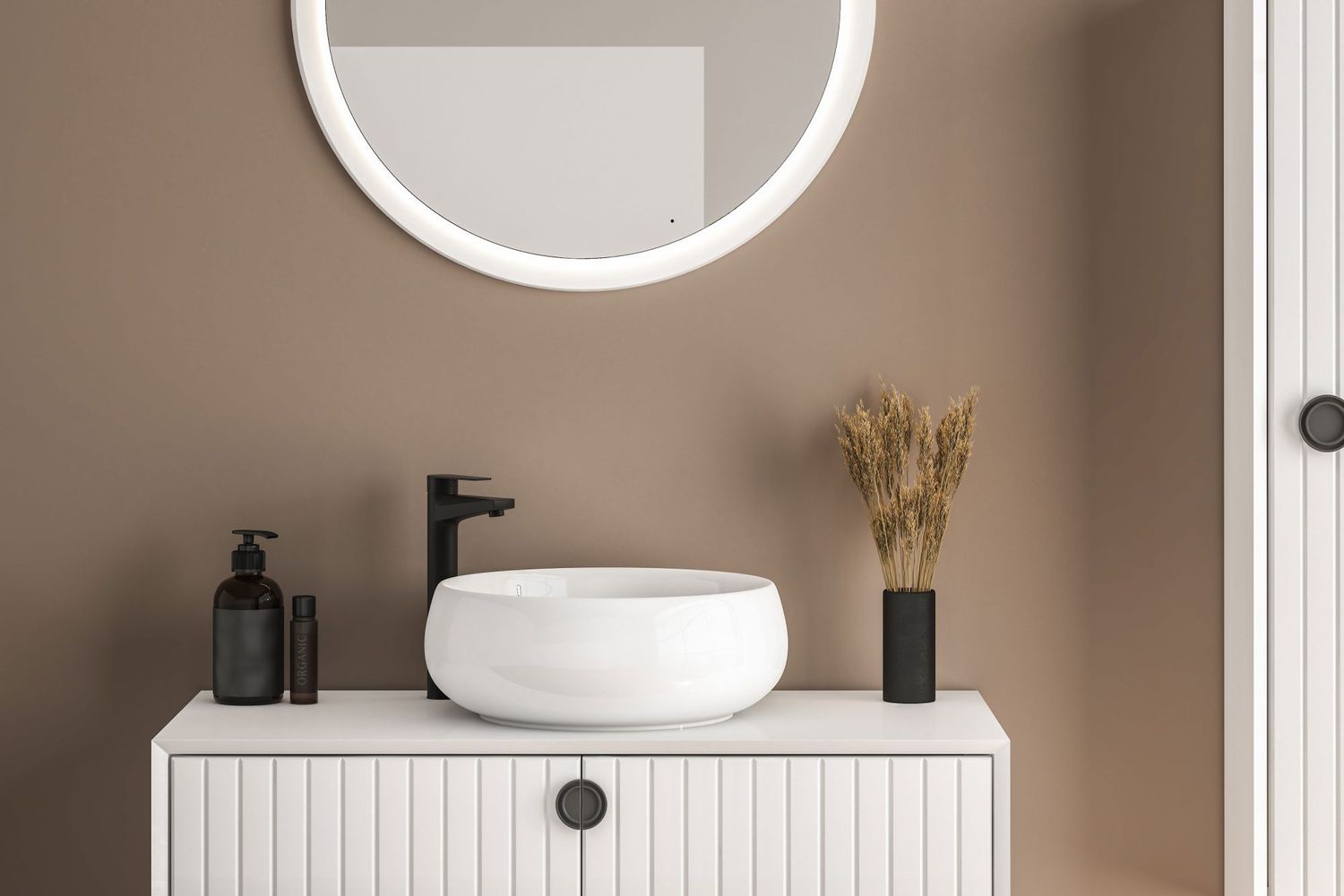Designing a small bathroom without natural light presents a unique challenge. Choosing the right paint color can significantly impact the space, making it feel more open, inviting, and comfortable. The absence of natural light requires careful consideration of color choices to avoid making the bathroom appear dark and cramped. This guide will explore various paint color options and provide practical advice on selecting the perfect hue for your space. We’ll delve into the characteristics of different colors, the effects of finishes, and how to complement your paint choice with lighting and decor to create a well-balanced and appealing bathroom environment.
Understanding the Challenges of Small, Windowless Bathrooms
Small bathrooms without windows can feel confined and dim, as they lack the natural light that often brings warmth and depth to a space. The limited space can also make it challenging to incorporate multiple design elements without overwhelming the room. Therefore, the goal in choosing paint colors is to create an illusion of space, brightness, and comfort.
The Role of Color in Enhancing Space
Color plays a vital role in influencing the perception of space. In small, windowless bathrooms, the right color can make the room feel larger, brighter, and more inviting. Here’s how different types of colors can affect a small bathroom:
- Light Colors: Light hues reflect more light, making the room feel more open and spacious. They are generally the best choice for small bathrooms without natural light.
- Dark Colors: While dark colors can add drama and depth, they can also make a small space feel even smaller and more enclosed if not used carefully.
- Warm Colors: Warm tones can make a space feel cozy but may also give the impression of a smaller area if overdone.
- Cool Colors: Cool colors can create a serene and calm atmosphere, often making the room feel larger.
Best Paint Color Choices for Small, Windowless Bathrooms
1. Soft Whites

Soft white paint is a classic choice for small bathrooms without natural light. White reflects light and can make the space feel clean and airy. However, it’s essential to choose the right shade of white to avoid the room looking too sterile. Opt for whites with warm undertones, like cream or ivory, to add a touch of warmth and prevent the space from feeling too cold or clinical.
- Advantages: Reflects artificial light well, creates a clean and fresh atmosphere.
- Suggestions: Eggshell or satin finishes can add a subtle sheen that enhances light reflection without being too shiny.
2. Pale Grays
Pale gray is another excellent option for small bathrooms with no windows. Gray is a neutral color that can add sophistication to the space without overwhelming it. Light gray tones can create a calming and elegant environment, especially when paired with white trim or fixtures.
- Advantages: Adds depth without being overpowering, pairs well with various decor styles.
- Suggestions: Choose a shade with cool undertones to create a soothing effect, and consider a matte or eggshell finish for a more contemporary look.
3. Soft Blues

Soft blue is a calming and refreshing color that can help open up a small bathroom. Light blues mimic the sky, which can make a windowless space feel less confined. This color works particularly well in bathrooms, as it evokes a sense of cleanliness and serenity.
- Advantages: Brings a tranquil and airy feel, complements white fixtures beautifully.
- Suggestions: A powder blue with a satin finish can reflect light softly, enhancing the sense of space.
4. Light Greens
Light green shades, such as mint or sage, can bring a sense of nature into a small bathroom, even without natural light. Green is often associated with freshness and renewal, making it a great choice for a bathroom setting.
- Advantages: Adds a natural and refreshing vibe, works well with wood or white accents.
- Suggestions: Consider a semi-gloss finish to help bounce light around the room.
5. Warm Neutrals
Warm neutrals like beige or taupe can create a cozy and inviting atmosphere in a small, windowless bathroom. These colors add warmth without making the space feel smaller, and they pair well with a variety of accent colors and materials.
- Advantages: Provides warmth and comfort, versatile for different decor styles.
- Suggestions: A matte or eggshell finish can give the walls a soft, sophisticated look without being too reflective.
6. Pastel Yellows
Pastel yellow is an uplifting and cheerful color that can brighten a small bathroom. It brings a sense of sunlight into a space that lacks natural light, making the room feel more inviting and open.
- Advantages: Creates a sunny, cheerful atmosphere, enhances light reflection.
- Suggestions: A soft yellow with an eggshell finish can add warmth and a subtle glow to the room.
7. Soft Pink or Blush
Soft pink or blush can add a gentle warmth to a small bathroom. This color is often associated with calmness and comfort, making it a good choice for creating a serene space. It also pairs beautifully with gold or brass fixtures for a touch of elegance.
- Advantages: Adds warmth without being overpowering, pairs well with metallic accents.
- Suggestions: A blush pink with a satin finish can create a soft, inviting glow in the bathroom.
8. Light Lavender
Light lavender can bring a touch of sophistication and calm to a small bathroom. This color works well in creating a serene and tranquil environment, which can be particularly beneficial in a bathroom setting. Lavender pairs nicely with white or silver accents.
- Advantages: Adds a soothing and elegant touch, enhances the sense of space.
- Suggestions: A matte finish can prevent the color from being too intense while still offering a soft glow.
The Impact of Finish on Paint Color
The finish of the paint you choose can significantly affect how the color appears in a small, windowless bathroom. Here’s a breakdown of common paint finishes and their effects:
- Matte Finish: Provides a smooth, non-reflective surface that can hide imperfections on the walls. However, it absorbs light rather than reflecting it, which might not be ideal for small, dark spaces.
- Eggshell Finish: Offers a slight sheen, providing a good balance between matte and glossy. It reflects some light, helping to brighten the room without being too shiny.
- Satin Finish: Has a soft sheen that reflects light well, making the space appear brighter. It’s also easy to clean, making it a practical choice for bathrooms.
- Semi-Gloss Finish: Highly reflective, which can enhance light in the bathroom and make it feel larger. However, it can also highlight imperfections on the walls, so it’s best used on smooth surfaces.
- Gloss Finish: The most reflective finish, making it ideal for maximizing light in a small bathroom. However, it can be too intense for large wall areas and is best used for trim or accents.
Complementing Paint Colors with Lighting
In a bathroom without natural light, artificial lighting plays a crucial role in how paint colors appear. Here are some tips on how to compliment your chosen paint color with the right lighting:
- Use Layered Lighting: Combine ambient, task, and accent lighting to create a balanced and well-lit space. This helps to avoid shadows and enhances the overall brightness of the room.
- Choose Warm Light Bulbs: Warm white bulbs (around 2700K to 3000K) can add warmth to the space, making it feel more inviting. This is particularly important if you’ve chosen cooler paint colors like gray or blue.
- Consider Dimmers: Installing dimmers allows you to adjust the light levels according to your needs, creating a more flexible and comfortable environment.
- Mirror Lighting: Adding lights around or behind mirrors can enhance the brightness and make the space feel larger.
Accenting with Trim and Fixtures
The color of your trim, fixtures, and accessories can significantly impact the overall look and feel of your bathroom. Here are some ideas for pairing these elements with your chosen wall color:
- White Trim: Crisp white trim can create a clean and defined look, especially when paired with soft, pastel wall colors. It can also help to brighten the space by reflecting light.
- Metallic Fixtures: Silver, chrome, or brushed nickel fixtures can add a sleek, modern touch that complements cool-toned colors like gray, blue, or lavender. Gold or brass fixtures work well with warmer tones like blush, beige, or soft pink.
- Wood Accents: Natural wood accents can add warmth and texture to the space, particularly when paired with light greens, beiges, or whites. Consider wood cabinets, shelves, or even a wood-framed mirror.
- Bold Accents: If you’ve chosen a neutral or light wall color, consider adding bold accents through towels, rugs, or artwork. Darker or vibrant colors can add interest and contrast without overwhelming the space.
Incorporating Patterns and Textures
Introducing patterns and textures can add depth and interest to a small bathroom. Here’s how to do it without making the space feel cluttered:
- Subtle Patterns: Opt for subtle patterns, such as light stripes or small-scale geometric designs, that can add visual interest without overwhelming the room. These can be incorporated through wallpaper, tiles, or even textured paint.
- Textured Paint: Textured paint finishes, such as Venetian plaster or a subtle stucco effect, can add a tactile dimension to the walls, enhancing the overall design.
- Accent Walls: Consider creating an accent wall with a bolder color or pattern. This can add depth and focus without closing in the space. Just ensure the rest of the room remains light and neutral to maintain balance.
- Tile Choices: If you’re incorporating tiles, consider using glossy tiles that reflect light or mosaic tiles that add texture and color variation. Vertical tiles can make the ceiling appear higher, enhancing the sense of space.
Final Touches: Accessories and Decor
The final touches in your bathroom can bring the whole design together. Here are some ideas to complement your chosen paint color:
- Mirrors: Large mirrors can reflect light and make the bathroom appear larger. Frameless mirrors or those with sleek, metallic frames work well in small spaces.
- Plants: If possible, introduce some greenery to add a touch of nature. Choose low-light plants or high-quality artificial plants to add freshness to the room.
- Towels and Rugs: Coordinate your towels and rugs with your wall color to create a cohesive look. For example, soft blues or grays can pair well with white or silver accents, while warm neutrals can be complemented with earthy tones.
- Artwork: Adding artwork to the walls can inject personality into the space. Choose pieces that complement your color scheme and don’t overwhelm the small area.
- Storage Solutions: Opt for sleek, space-saving storage options like floating shelves, recessed cabinets, or over-the-toilet storage to keep the bathroom organized without cluttering it.
Conclusion
Choosing the right paint color for a small bathroom with no natural light requires careful consideration. By opting for light, reflective colors and pairing them with the right finishes, lighting, and decor, you can transform the space into a bright, inviting, and stylish room.
Whether you prefer the classic simplicity of soft white, the serene calm of light blue, or the warm embrace of pastel yellow, the key is to create a balanced environment that maximizes the limited space and artificial light available.
With the right choices, your small, windowless bathroom can become a cozy and functional oasis that defies its size and lack of natural light.




